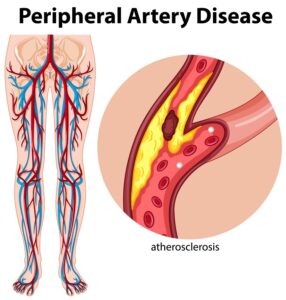 New research published in the Journal of the American Heart Association suggests that walking at a pace that induces pain or discomfort could improve walking ability among patients with peripheral artery disease (PAD).
New research published in the Journal of the American Heart Association suggests that walking at a pace that induces pain or discomfort could improve walking ability among patients with peripheral artery disease (PAD).
While most people believe they must stop exercising when experiencing pain, this study demonstrates that that thought may not apply to all situations.
Advertisement
Peripheral artery disease occurs when the arteries that transport blood from the heart throughout the body narrow, reducing oxygen and blood flow. It usually affects the feet and legs and causes pain and discomfort while walking, causing symptoms such as cramping, fatigue, weakness, and aching. Previous studies have shown that walking on a treadmill can improve walking ability and distance among people with PAD. However, it remained unclear how walking at a pace that induced symptoms such as leg pain could affect speed, balance, and strength.
This new study examined the effects of home-based walking for exercise among 264 people with PAD who were participating in a randomized clinical trial called the Low-Intensity Exercise Intervention in PAD (LITE.). Participants were randomly assigned to one of three groups for 12 months.
The first group walked at home at a comfortable pace, and the second group walked at home at a pace that induced leg symptoms. The third group did not walk for exercise. Both walking exercise groups wore an ActiGraph, a device that monitored the time they walked and the intensity.
Participants completed three tests in total during the study — one at the start of the study, one at six months, and one at 12 months. All tests included leg function: walking speed over a four-meter distance (13 feet) at usual pace, walking speed over a four-meter distance at the fastest pace, and the short physical performance battery (SPPB), which consisted of four-meter walking velocity at usual pace, a standing balance test, and the time for five repeated chair rises.
It was found that after six months, participants who had induced leg pain or discomfort walked 11 feet per minute faster, and at 12 months, they walked more than 16 feet per minute faster than participants who walked but did not experience any pain.
After 12 months, people who walked for exercise with leg pain or discomfort saw a significant difference in the leg function tests. In those walking for exercise at a comfortable pace and those who did not walk, there was no improvement in walking at six months or 12 months.
Advertisement
“We were surprised by the results because walking for exercise at a pace that induces pain in the legs among people with PAD has been thought to be associated with damage to leg muscles,” said senior study author Mary M. McDermott, M.D. “Based on these results, clinicians should advise patients to walk for exercise at a pace that induces leg discomfort, instead of at a comfortable pace without pain.”
Researchers hope this study can help to assist in the prevention of PAD and the treatment of cardiovascular risk, and the improvement of quality of life for those living with the disease.
Blood Flow and General Health
People with PAD are not the only ones who should be concerned about blood flow. As the body ages, the arteries may need a hand to remain strong and healthy to help ensure blood can constantly flow without any problems.
Clinical Strength Artery Support is designed to give your arteries and circulation the support it needs. Using a powerful combination of L-citrulline, green coffee extract, green tea extract, and essential vitamins, Clinical Strength Artery Support can help to promote healthier and stronger arteries. As artery function decreases with age, this unique formula can help them stay healthy.
